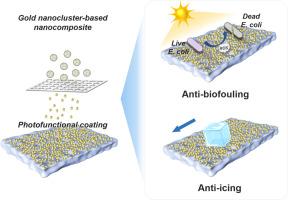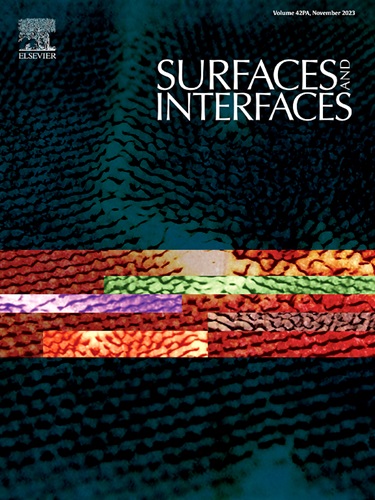Photofunctional gold nanocluster-based nanocomposite coating for enhancing anti-biofouling and anti-icing properties of flexible films
IF 5.7
2区 材料科学
Q2 CHEMISTRY, PHYSICAL
引用次数: 0
Abstract
Elastomeric materials have garnered significant attention across biomedical and industrial fields. Multifunctionality and environmental stability are essential requirements for the application of these materials. Herein, we developed photofunctional gold nanocluster-based nanocomposites (SiO2-AuNC) and coated them on elastomeric polydimethylsiloxane (PDMS) films through one-step way to enhance anti-biofouling and anti-icing properties. The SiO2-AuNC coating, created by immobilizing ultra-small gold nanoclusters (AuNCs) onto hydrophobic silica nanoparticles surface using a gel-sol method, forms an island-like convex structure. The immobilization significantly enhanced radiative transitions and promoted the generation of reactive oxygen species of AuNCs, which provided robust anti-biofouling property through photosensitization to the films. Meanwhile, the rigid SiO2-AuNC nanocomposite markedly enhances the wear resistance of the films. Additionally, the hierarchical micro- and nanostructure of SiO2-AuNC coating increases the hydrophobicity of the films, effectively preventing the aggregation of supercooled water droplets, thereby providing superior and durably anti-icing properties. This one-step coating provides a simple and effective strategy for multifunctional surface modification with nanoparticles, showing potential biomedical and industrial applications.

基于光功能金纳米簇的纳米复合涂层,用于增强柔性薄膜的防生物污损和防结冰性能
在生物医学和工业领域,弹性材料备受关注。多功能性和环境稳定性是这些材料应用的基本要求。在此,我们开发了基于光功能金纳米团簇的纳米复合材料(SiO2-AuNC),并通过一步法将其涂覆在弹性聚二甲基硅氧烷(PDMS)薄膜上,以增强其抗生物污损和抗结冰性能。采用凝胶溶胶法将超小型金纳米团簇(AuNCs)固定在疏水性二氧化硅纳米粒子表面,形成了SiO2-AuNC涂层,并形成了岛状凸起结构。这种固定方式大大增强了金纳米团簇的辐射跃迁,促进了活性氧的生成,通过光敏化作用使薄膜具有很强的抗生物污染性能。同时,硬质 SiO2-AuNC 纳米复合材料明显提高了薄膜的耐磨性。此外,SiO2-AuNC 涂层的分层微观和纳米结构增加了薄膜的疏水性,有效防止了过冷水滴的聚集,从而提供了卓越而持久的防冰性能。这种一步法涂层为纳米粒子的多功能表面改性提供了一种简单有效的策略,具有潜在的生物医学和工业应用前景。
本文章由计算机程序翻译,如有差异,请以英文原文为准。
求助全文
约1分钟内获得全文
求助全文
来源期刊

Surfaces and Interfaces
Chemistry-General Chemistry
CiteScore
8.50
自引率
6.50%
发文量
753
审稿时长
35 days
期刊介绍:
The aim of the journal is to provide a respectful outlet for ''sound science'' papers in all research areas on surfaces and interfaces. We define sound science papers as papers that describe new and well-executed research, but that do not necessarily provide brand new insights or are merely a description of research results.
Surfaces and Interfaces publishes research papers in all fields of surface science which may not always find the right home on first submission to our Elsevier sister journals (Applied Surface, Surface and Coatings Technology, Thin Solid Films)
文献相关原料
公司名称
产品信息
百灵威
anhydrous ethanol
¥14.00~¥34800.90
百灵威
sodium hydroxide
¥15.00~¥24697.17
百灵威
Glutathione
¥14.00~¥23572.00
百灵威
ammonium hydroxide
¥12.00~¥10073.28
百灵威
tetraethyl orthosilicate
¥20.00~¥5928.00
百灵威
2′,7′-dichlorofluorescein diacetate
 求助内容:
求助内容: 应助结果提醒方式:
应助结果提醒方式:


